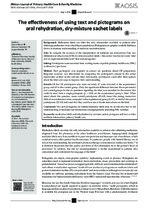| dc.contributor.author | Heyns, Jeanne | |
| dc.contributor.author | van Huyssteen, Mea | |
| dc.contributor.author | Bheekie, Angeni | |
| dc.date.accessioned | 2021-09-03T10:51:14Z | |
| dc.date.available | 2021-09-03T10:51:14Z | |
| dc.date.issued | 2021 | |
| dc.identifier.citation | Heyns, J. et al. (2021). The effectiveness of using text and pictograms on oral rehydration, dry-mixture sachet labels . African Journal of Primary Health Care and Family Medicine, 13(1), 1–11. https://doi.org/10.4102/PHCFM.V13I1.2646 | en_US |
| dc.identifier.issn | 2071-2936 | |
| dc.identifier.uri | https://doi.org/10.4102/phcfm.v13i1.2646 | |
| dc.identifier.uri | http://hdl.handle.net/10566/6608 | |
| dc.description.abstract | Medication labels are often the only information available to patients after obtaining medication from a healthcare practitioner. Pictograms are graphic symbols that have shown to increase understanding of medicine use instructions. To compare the accuracy of the interpretation of medicine use instructions from two different oral rehydration (OR) dry-mixture sachet labels – the control ‘routine textonly’ label and an experimental label with ‘text-and-pictograms’. Participants were recruited from waiting rooms in public primary health care (PHC) facilities in Cape Town.
Method: Each participant was required to answer six questions about OR preparation. Response accuracy was determined by comparing the participant’s answer to the actual information written on the relevant label. Afterwards, participants could offer their opinion about the label and ways to improve their understanding. | en_US |
| dc.language.iso | en | en_US |
| dc.publisher | AOSIS | en_US |
| dc.subject | Medication label | en_US |
| dc.subject | Oral rehydration | en_US |
| dc.subject | Primary health care | en_US |
| dc.subject | Dry-mixture sachet | en_US |
| dc.subject | Healthcare practitioner | en_US |
| dc.title | The effectiveness of using text and pictograms on oral rehydration, dry-mixture sachet labels | en_US |
| dc.type | Article | en_US |

